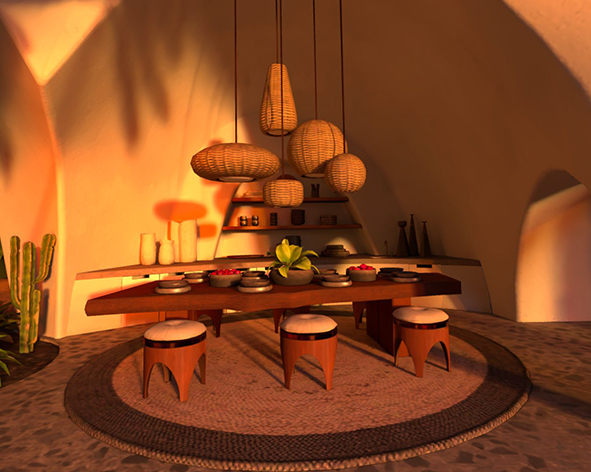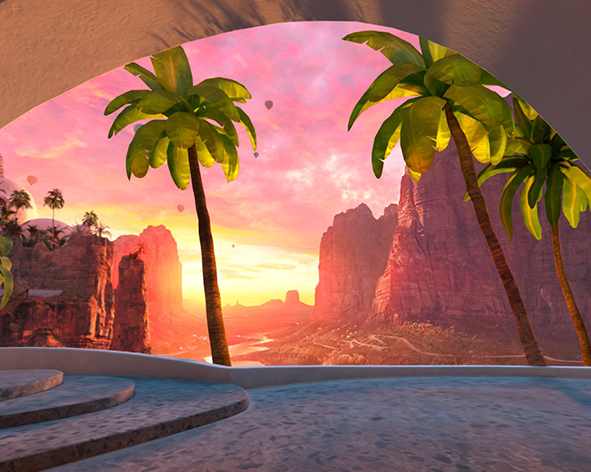Quest Environment




Description of the space
Desert Terrace looks like the lobby of a hotel in an oriental country, looking over a beautiful sunset and palmtrees. It consists of lounge areas overlooking the view, and an open kitchen in the back, overviewing the entire space. The space is aesthetically very serene and vacation-like. Dark woods, rattan lighting fixtures, and light grey stones are at the heart of Desert Terrace. The structure and furniture are organic, giving the space an extra touch of warmth. The roof has circular openings, giving the user the opportunity to gaze at the stars and moon. The overall hues are warm, earthy, with a touch of pink generated by the sunset. Lighting is subdued, and the shades of the sunset reflect on the walls and ceiling, additionally creating beautiful shadows mirrored by the palmtrees. Desert Terrace literally is what its title describes, a terrace in the middle of the desert.
Athmosphere
After spending some time in each room, I quickly noticed I was getting headaches in all the “fake architecture” environments but not in the environment called Bubble. I, therefore, picked the Desert Terrace environment for this exercise because, although very impressive and quite beautifully designed, I did not expect to prefer the abstract space, Bubble. After spending some time in the space, I could feel an instant headache overpowering the beauty of it all. Because the space is blurry, your eyes try very hard to see things sharply and fail, which then leads to a horrible headache. Despite it being an aesthetically pleasing environment in terms of colors, shapes, and design, the overall blurriness of the space obstructs the experience at some point. Considering I have really bad eyes (-7,50), perhaps I get headaches sooner than others, but it is an unavoidable circumstance for anyone after spending time in a blurry VR space.
Description by Nell Beller
Desert Terrace looks like the lobby of a hotel in an oriental country, looking over a beautiful sunset and palmtrees. It consists of lounge areas overlooking the view, and an open kitchen in the back, overviewing the entire space. The space is aesthetically very serene and vacation-like. Dark woods, rattan lighting fixtures, and light grey stones are at the heart of Desert Terrace. The structure and furniture are organic, giving the space an extra touch of warmth. The roof has circular openings, giving the user the opportunity to gaze at the stars and moon. The overall hues are warm, earthy, with a touch of pink generated by the sunset. Lighting is subdued, and the shades of the sunset reflect on the walls and ceiling, additionally creating beautiful shadows mirrored by the palmtrees. Desert Terrace literally is what its title describes, a terrace in the middle of the desert.
Athmosphere
After spending some time in each room, I quickly noticed I was getting headaches in all the “fake architecture” environments but not in the environment called Bubble. I, therefore, picked the Desert Terrace environment for this exercise because, although very impressive and quite beautifully designed, I did not expect to prefer the abstract space, Bubble. After spending some time in the space, I could feel an instant headache overpowering the beauty of it all. Because the space is blurry, your eyes try very hard to see things sharply and fail, which then leads to a horrible headache. Despite it being an aesthetically pleasing environment in terms of colors, shapes, and design, the overall blurriness of the space obstructs the experience at some point. Considering I have really bad eyes (-7,50), perhaps I get headaches sooner than others, but it is an unavoidable circumstance for anyone after spending time in a blurry VR space.
Description by Nell Beller
Introduction | Editorial | References | Projects | Research
HEAD – Genève | Interior Architecture | Atelier Simon Husslein | Copyright © 2025